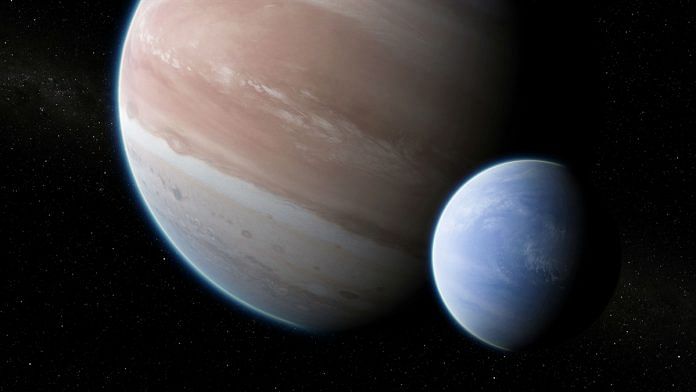The ‘exomoon’ was found orbiting exoplanet Kepler-1625b — around 4,000 light years away from earth — by two Columbia University astronomers.
Bengaluru: Astronomers may have just found the very first moon outside of our solar system. This ‘exomoon’ is the size of Neptune, far bigger than any moon astronomers had expected to find, and challenges the theories of planet and satellite formation.
The findings were published by two Columbia University astronomers on 3 October in the journal Science Advances.
Over the last 20 years or so, over 2,000 exoplanets — planets outside our solar system — have been spotted and identified. Most of these are gargantuan in size, an obvious observational bias because their size makes it easier to observe them.
The most common method to observe these exoplanets is called the transit method. Telescopes are set to observe one star for long periods of time, and if the angle is correct, can spot a planet orbiting around it when it briefly blocks out a minuscule amount of light. By calculating how much light it blocks, scientists can deduce the size (not mass) of the planet. By observing how frequently this occurs, they can deduce the orbital period as well.
Also read: It’s not a planet or a comet. But this icy Goblin is another thrilling key to the universe
Discovery and confirmation
Astronomers Alex Teachey and David Kipping set out to hunt for exomoons using the Kepler space telescope, and analysed the data of 284 exoplanets discovered by Kepler. After combing through it, they focussed on the exoplanet Kepler-1625b, about 4,000 light years away from earth.
It had all the right numbers: It was several times bigger than Jupiter, orbited a host star that is similar in mass to the sun, and is located at the same distance as the earth from sun. It seemed to show signs of a moon: Regular and periodic — and slight — dimming of the star’s light after the planet transited.
They were hoping to find a moon that was the size of Jupiter’s large moons, and then requested for a more detailed observation with the Hubble telescope.
Last October, they observed the exoplanet’s fourth transit around its star with Hubble, and it confirmed their findings.
“It was a shocking moment to see that light curve, my heart started beating a little faster and I just kept looking at that signature,” said lead author Teachey, NSF Graduate Fellow in astronomy at Columbia. “But we knew our job was to keep a level head testing every conceivable way in which the data could be tricking us until we were left with no other explanation.”
In the Hubble data, they saw a moon tugging along, “trailing the planet like a dog following its owner on a leash”. The confirmation came both in the form of a second transient dip, as well as a ‘wobble’.
Second confirmation
A body in orbit around another is actually a system of the two bodies orbiting each other around a common barycentre. In the case of earth and sun, for example, since both bodies have mass, both exert gravitational pull on each other. But the sun’s is much more powerful, and given its size, the barycentre of the earth-sun system is inside the sun itself. But for the Sun-Jupiter system, the barycentre lies just outside of the sun. Thus, observation of Jupiter going around the sun will actually show the sun also wobbling around a point just outside of its body.
This is in fact a second method used to detect exoplanets, and help find planets that have a large mass (not necessarily size). This was the same method used to further offer support to the existence of an exomoon. A faraway observer with a powerful telescope would see our earth-moon system orbiting the sun in a similar fashion. The exosystem is further similar to our moon, at 1.5 per cent the exoplanet’s mass.
Also read: Liquid water on Mars is no surprise but here’s why it makes the planet tougher to explore
Challenging old theories
The exomoon appears to have challenged our theories on how natural satellites form. A Neptune-sized moon is both unusual and unexpected.
“This would be the first case of detecting a moon outside our solar system,” said Kipping, an assistant professor of astronomy at Columbia. “If confirmed by follow-up Hubble observations, the finding could provide vital clues about the development of planetary systems and may cause experts to revisit theories of how moons form around planets.”
Even though they lie within their system’s habitable zone, both the exoplanet and the exomoon are gaseous and thus unsuitable for life.






